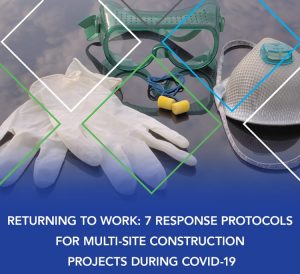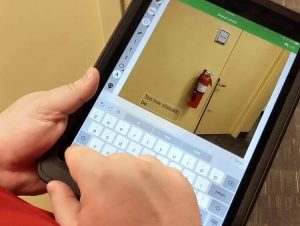 The COVID-19 outbreak is an evolving situation. With state and local authorities updating restrictions and guidelines regularly, constraints for returning to work vary by location and are ever-changing. As the nation returns to work, it is critical to develop protocols for construction projects that enable work to proceed, will keep our workforce healthy, and that provide employees with enhanced communication and training.
The COVID-19 outbreak is an evolving situation. With state and local authorities updating restrictions and guidelines regularly, constraints for returning to work vary by location and are ever-changing. As the nation returns to work, it is critical to develop protocols for construction projects that enable work to proceed, will keep our workforce healthy, and that provide employees with enhanced communication and training.
Following are seven ways to prepare a project site and team as you return to conducting work in this post-COVID world.
Plan your work and work your plan:
1. Know Your Risk and Hazard Levels
Before returning to work, understand and comply with Occupational Safety and Health Administration (OSHA) reporting requirements to provide workers with the safest work environment. Additionally, following the frequently updated guidelines provided by federal, state, county and local authorities will be imperative. On a granular level, we suggest naming a safety champion who can ensure local County Public Health Department directives for your jobsites and locations are being followed.
2. Establish Health Screenings
As many organizations build a policy around pre-work health screenings, we recommend following Equal Employment Opportunity (EEOC) guidance. These screenings will vary by worksite and may include:
- Establishing a baseline health questionnaire to pre-screen employees daily
- Providing temperature checks before the workday begins and upon re-entering the jobsite
- Communicating and enforcing Personal Protective Equipment (PPE) and sanitation protocols
3. Jobsite Modifications for COVID-19
To promote safety and reduce the spread of bacteria and viruses, it is imperative that modifications are made to jobsites. Some suggestions include:
- Social Distancing: Stagger shifts and trades to support occupancy limits and social distancing practices. When possible, create zones on the jobsite so workers stay contained to specific areas, reducing the level of contact with others. Establish occupancy limits and spacing for workspaces including trailers, break areas, workspaces, and equipment. Implement one-way traffic flows for workers in high traffic areas wherever possible to provide additional distancing.
- Signage for Communication: Provide visual reminders and signage (multi-lingual) at key areas of jobsite including entry points, break and work areas. Reminders of new processes and procedures and social distancing will help the jobsite stay as safe as possible. This will not only serve employees, but also educate on-demand or temporary workers on-site safety protocols.
- Enhanced Cleaning: Establish a cleaning and decontamination protocol before entry and exit of the jobsite. Utilize this protocol at commonly touched and high traffic areas. Also provide sanitation stations and handwash breaks at least once an hour. Work them into the daily schedule to ensure employees comply.
- Pre-Work Health Screening: Arrange a pre-work health screening area for questionnaires and temperature checks prior to entering the jobsite. A Personal Protective Equipment (PPE) check should be conducted during this time. All employees must pass through the screening prior to working.
- Site Visitors: Evaluate visitor protocols with possible implementation of prior approval and an on-site screening process. Provide a dedicated space to receive deliveries and materials.
4. Develop Plans for Sick Workers
Have a Confirmed Positive Response Plan in place for workers who experience symptoms or become sick. While we hope to never have an employee or team member become ill, it is best to develop policies and procedures for prompt identification and isolation of sick workers as a precaution. After an ill employee is identified, have a critical incident response and disinfection plan ready for implementation.
5. Establish Jobsite Disinfection Protocols

Follow United States Environmental Protective Agency (EPA) guidelines specific to the types of chemicals and products in use. These products should also have designated areas for safe storage and handling instructions according to the Safety Data Sheet (SDS) guidelines. Ensure you understand the difference between cleaning and disinfecting, and follow Center for Disease Control and Prevention (CDC) guidelines. Consider which spaces require disinfection (and how frequently it must be done) for key workspaces, break areas, restrooms, community vehicles, tools, and shared equipment.
6. Modify Worker Behaviors for Safety
Keep your workforce as safe and protected as possible with providing proper PPE, installing signage to communicate changes in processes, modifying jobsite flows to allow for social distancing, and leveraging the use of technology. Modify “tailgate and toolbox talks” or jobsite “Safety Meetings” to promote safe social distancing while allowing workers to continue these essential conversations. Safety mindsets should extend beyond the jobsite to allow everyone to return home safely every day. Additionally, performing a Job Safety Analysis (JSA) in advance can aid in determining exposure risk. This will allow the development of a site-specific COVID-19 safety plan to supplement your JSA. Remember to review OSHA Guidelines for a construction workforce.
7. Sharing is not caring
With social distancing in mind, companies can aid in keeping others safe by providing touchless solutions wherever possible. Beyond that, it is best to avoid sharing tools or equipment whenever possible. If possible, supply options for workers to store food and water separately from others.
 Sevan is supporting the revival of construction activities by helping owners execute the seven protocols outlined above. We also provide technology, analytics, and program management to help companies understand what needs to take place and prioritize their work across their locations.
Sevan is supporting the revival of construction activities by helping owners execute the seven protocols outlined above. We also provide technology, analytics, and program management to help companies understand what needs to take place and prioritize their work across their locations.
- Slingshot, Powered by Sevan ANALYZE™ helps Multi-Site clients:
- Overlay project site data with state & local COVID-19 information
- Gain visibility for proactive planning and decision-making for a large number of sites across a wide geography
- Ensure access to adequate workforce and required materials for projects
- Strategically and effectively leverage capital budgets
- Sevan CAPTURE™ provides:
- Inventory of work completed across sites
- Visibility to construction activities
- Record-keeping and virtual inspections
- Job Safety Analysis (JSA) and Risk Management
- COVID-19 Compliance and Audit Inspections
- Virtual 360 tours of work in progress
- Other Technology Solutions including building IoT, wearables, apps, cameras:
- Procure and implement technology
- Communicate project progress
- Support proximity and contact tracing
- Provide visualization of site activities
- Manage on-site health screenings.
By preparing a thorough and comprehensive plan for returning to work, construction professionals enter a safe and monitored working environment. These efforts can also help to ease the minds of employees and customers during uncertain times.
Looking for more content surrounding the industry and other similar topics?
